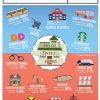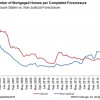Why Some U.S. Real Estate Markets Are Increasing in Home Sales
This spring where will the most houses be sold? In the Midwest, the most recent numbers reveal.
All across the U.S., buyers were snapping up houses, shoving the amount of dwellings under contract for sale in February 29% higher than January, the National Association of Realtors reported on Monday. That’s looking at the real amounts, rather than those that are corrected to compensate for seasonal changes.
And those pending sales amounts were 5.1% higher than February 2015, driven by a surge of wannabe homeowners forking over down payments for properties in the Midwest. The report monitors not new building and just present dwellings.
“We’re eventually seeing signs of pent up demand beginning to raise sales,” says Geoffrey Jones, CEO of investorwize.com, in a statement.
He also credits the spike to super-low mortgage rates and, at last, the stabilization of the stock market.
“Two variables—low inventories and tight credit—will limit the gains we’ll find in 2016 he calls. Despite that, he says, “we should find this springtime materialize as the most busy season of sales since 2006.”
That may be particularly accurate in the Midwest, where houses frequently are sold before the “For Sale” sign is securely put in the front yard.
Each of the state’s with a score of 100 being approximately equal to about 5 million houses under contract over the course of a complete year four areas was rated on an index.
The Midwest earned a score of 119.6, a 61.4% jump in houses under contract compared with January and a 7.2% increase over the preceding year, according to the report.
There’s a deficit of houses for sale in the Midwestern city of Omaha, says a realtor at Nebraska Realty, Judy Dooley.
“When houses come up in the marketplace, they’re selling in a matter of hours with multiple offers if they’re not overpriced.”
The Omaha-based broker attributes the credit crunch, in part, on investors who swooped in and picked up many of the properties that were more affordable when they reach rock bottom costs during the fiscal catastrophe. Many of those same investors are’t selling, which means there are’t enough houses in the marketplace that meet the budgets of most first-time buyers.
To satisfy demand, she’s as aspiring homeowners go further out into the suburbs seeing a spike in new building. More subdivisions are going up in all ways, she says.
In Nebraska, there much property,” Dooley says. So they’re constructing.” “Folks are’t locating present homes
More houses usually go on the market after the Super Bowl, at least in the Minneapolis–St. Paulplace, says Barry Berg, a Minneapolis realtor at Berg Larsen Group of Coldwell Banker Burnet.
After the holidays, “abruptly, there aren’t any parties anymore folks and ” begin reevaluating like to reside where they’d, he says. Around an identical time, firms have a tendency to make lots of their hiring (and firing) choices—which also drives home sales.
And with the variety of houses in the marketplace down about 10% from last year, those properties that are just listed immediately translate into more sales, Berg says.
“When fresh listings come to the marketplace, the buyers all of a sudden beginning to feel nervous,” he says. “They figure they’d better act fast.”
The rate of pending sales in the Midwest was followed by the South at 111.1, up 3.5% from the preceding year; the West, at 96.2, down 1.6% from last year; and the Northeast, at 83.1, up 17.5% from February 2015.
The reason that the West, generally a juggernaut in house sales, is finding a slow down is that it was the first to regain from the housing catastrophe with higher costs, realtor.com’s Smoke says. As there are’t enough houses in the marketplace for buyers to scoop up it ’s fighting to continue its impetus.
Meanwhile, Northeast and the Midwest took the longest to recover.
“They’re now reaching a normalcy point with demand more powerful and foreclosures on the wane,” Smoke’s statement says. “The South is a combination of the two, with Texas having been powerful like California [in the West] but other components just now hitting their stride, like Florida and Georgia.”
- Created On: May 2, 2016
- Last Updated On: May 2nd, 2016 at 10:04 pm
- No Comments














